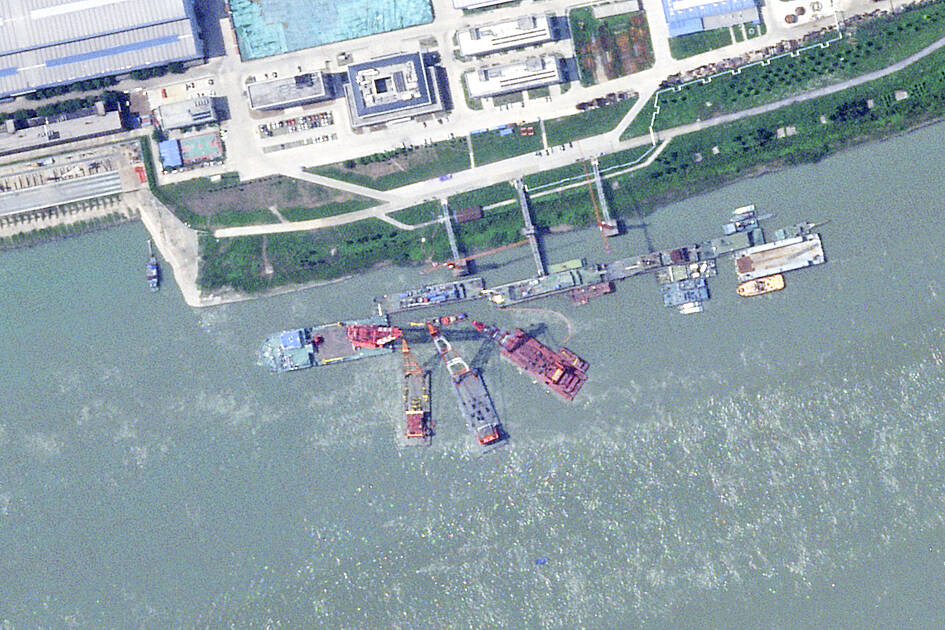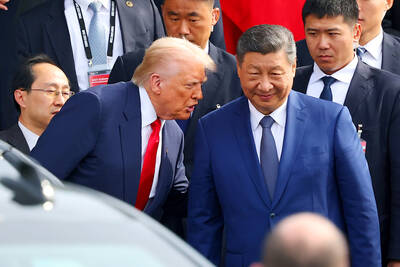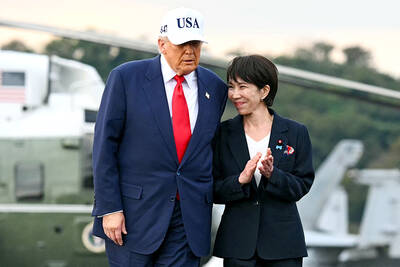Satellite imagery showed that China’s newest nuclear-powered attack submarine sank alongside a pier while under construction, a senior US defense official said on Thursday.
The sinking of China’s first Zhou-class submarine represents a setback for Beijing as it continues to build out the world’s largest navy. Beijing has become increasingly assertive in pursuing its claim to virtually the entire South China Sea, which is crucial to international trade.
The submarine likely sank between May and June, when satellite images showed cranes that would be necessary to lift it off the bottom of the river, said the official, who spoke on condition of anonymity to provide details about the submarine loss.

Photo: AP
China has been building up its naval fleet at a breakneck pace, and the US considers China’s rise one of its main future security concerns.
A Chinese Ministry of Foreign Affairs spokesperson yesterday said that he was not familiar with the topic and did not provide any information when asked about it at a news conference in Beijing.
The US official said it was “not surprising” that China’s navy would conceal it. The submarine’s current status is unknown.
The identification of the sunken nuclear submarine was first reported by the Wall Street Journal.
Thomas Shugart, a former US Navy submariner and an analyst at the Center for a New American Security, first noticed the incident involving the submarine in July, though it was not publicly known at the time that it involved the new Zhou-class vessel.
Satellite images from Planet Labs PBC analyzed by The Associated Press show what appears to be a submarine docked at the Shuangliu shipyard on the Yangtze River before the incident.
An image taken on June 15 appears to show the submarine either fully or partially submerged just under the river’s surface, with rescue equipment and cranes surrounding it. Booms surround it to prevent any oil or other leaks from the vessel.
A satellite image taken on Aug. 25 shows a submarine back at the same dock as the submerged vessel. It is not clear if it was the same one.
It remains unclear if the affected submarine had been loaded with nuclear fuel or if its reactor was operating at the time of the incident. However, there has been no reported release of radiation in the area in the time since.
China as of last year operated six nuclear-powered ballistic missile submarines, six nuclear-powered attack submarines and 48 diesel-powered attack submarines, a US military report said.
News of the submarine’s sinking comes as China this week conducted a rare launch of an intercontinental ballistic missile into international waters in the Pacific Ocean. Experts say it marked the first time Beijing had conducted such a test since 1980.

UKRAINE, NVIDIA: The US leader said the subject of Russia’s war had come up ‘very strongly,’ while Jenson Huang was hoping that the conversation was good Chinese President Xi Jinping (習近平) and US President Donald Trump had differing takes following their meeting in Busan, South Korea, yesterday. Xi said that the two sides should complete follow-up work as soon as possible to deliver tangible results that would provide “peace of mind” to China, the US and the rest of the world, while Trump hailed the “great success” of the talks. The two discussed trade, including a deal to reduce tariffs slapped on China for its role in the fentanyl trade, as well as cooperation in ending the war in Ukraine, among other issues, but they did not mention

Japanese Prime Minister Sanae Takaichi yesterday lavished US President Donald Trump with praise and vows of a “golden age” of ties on his visit to Tokyo, before inking a deal with Washington aimed at securing critical minerals. Takaichi — Japan’s first female prime minister — pulled out all the stops for Trump in her opening test on the international stage and even announced that she would nominate him for a Nobel Peace Prize, the White House said. Trump has become increasingly focused on the Nobel since his return to power in January and claims to have ended several conflicts around the world,

REASSURANCE: The US said Taiwan’s interests would not be harmed during the talk and that it remains steadfast in its support for the nation, the foreign minister said US President Donald Trump on Friday said he would bring up Taiwan with Chinese President Xi Jinping (習近平) during a meeting on the sidelines of the APEC Summit in South Korea this week. “I will be talking about Taiwan [with Xi],” Trump told reporters before he departed for his trip to Asia, adding that he had “a lot of respect for Taiwan.” “We have a lot to talk about with President Xi, and he has a lot to talk about with us. I think we’ll have a good meeting,” Trump said. Taiwan has long been a contentious issue between the US and China.

Taiwan’s first African swine fever (ASF) case has been confirmed and would soon be reported to the World Organization for Animal Health (WOAH), Minister of Agriculture Chen Junne-jih (陳駿季) yesterday. The Ministry of Agriculture’s Veterinary Research Institute yesterday completed the analysis of samples collected on Tuesday from dead pigs at a hog farm in Taichung and found they were ASF-positive. Animal and Plant Health Inspection Agency Animal Quarantine Division chief Lin Nien-nung (林念農) said the result would be reported to the WOAH and Taiwan’s major trade partners would also be notified, adding that pork exports would be suspended. As of Friday, all samples